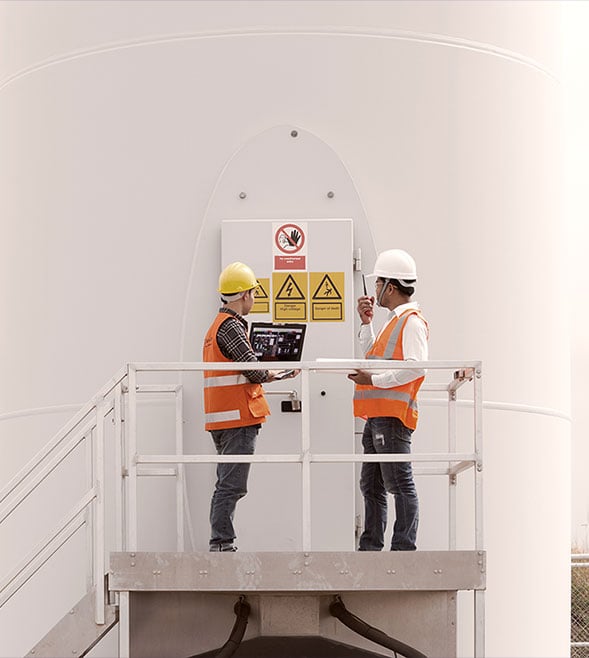-
Governance advisory
We guide boards and management teams in frameworks, team processes and leadership dynamics to deliver sustainable value.
-
Financial services advisory
Get market-driven expertise to achieve your goals in banking, insurance, capital markets, and investment management.
-
Business risk services
Our market-driven expertise helps firms keep growing and manage risk in an evolving regulatory landscape.
-
Risk
Meet risks with confidence and transform your business – we support you to manage risk and deliver on your goals.
-
Economic consulting
Bespoke guidance grounded in complex economic theory and practical sector insight to help you make the right decisions.
-
Government and public sector
Experience and expertise in delivering quality public sector advisory and audits.
-
Business consulting
Partnering with you to deliver sustainable business change that helps you realise your ambitions.
-
Transaction advisory services
Whether buying or selling, we help you get the deal done with our comprehensive range of transaction advisory services.
-
Financial accounting advisory services (FAAS)
Our FAAS team can support your finance function with the flexible resource they need to get results.
-
Corporate finance advisory
Building a business is never easy. We help you maximise the value of your business and find the right option.
-
Valuations
Help to understand or support the valuation of a business or asset.
-
Insolvency and global asset recovery
We provide asset tracing and seamless cross-border global recovery for clients.
-
Forensic and investigation services
Market-driven expertise in investigations, dispute resolution and digital forensics.
-
Restructuring
Our restructuring team help lenders, investors and management navigate contingency plans, restructuring and insolvency.
-
Transformation consulting
Is business transformation a priority for your organisation? Our expert insight and guidance can help you achieve it.
-
Pensions assurance
A tailored service that responds to evolving risks and regulations.
-
Accounting services
Optimise your growth with expert accounting services. Contact us today.
-
Royalty and intellectual property (IP) audits
Enhance IP asset protection with our royalty and IP audit services. Expertise in licensing, revenue detection, and compliance improvements.

-
Business consulting
Partnering with you to deliver sustainable business change that helps you realise your ambitions.
-
Corporate Simplification
Release value, reduce compliance complexity, and improve tax efficiency by streamlining your group structure.
-
Economic consulting
Bespoke guidance grounded in complex economic theory and practical sector insight to help you make the right decisions.
-
Financial accounting advisory services (FAAS)
Our FAAS team can support your finance function with the flexible resource they need to get results.
-
Governance advisory
We guide boards and management teams in frameworks, team processes and leadership dynamics to deliver sustainable value.
-
International
Unlock global opportunities with our local expertise and worldwide reach.
-
People advisory
Driving business performance through people strategy and culture.
-
Strategy Group
Successful business strategy is rooted in a clear understanding of the market, customer segmentation and how purchase decisions vary.
-
Respond: Data breach, incident response and computer forensics
Are you prepared for a cyber failure? We can help you avoid data breaches and offer support if the worst happens.
-
Comply: Cyber security regulation and compliance
Cyber security regulation and compliance is constantly evolving. Our team can support you through the digital landscape.
-
Protect: Cyber security strategy, testing and risk assessment
Cyber security threats are constantly evolving. We’ll work with you to develop and test robust people, process and technology defences to protect your data and information assets.

-
Corporate finance advisory
Building a business is never easy. We help you maximise the value of your business and find the right option.
-
Debt advisory
Working with borrowers and private equity financial sponsors on raising and refinancing debt. We can help you find the right lender and type of debt products.
-
Financial accounting advisory services (FAAS)
Our FAAS team can support your finance function with the flexible resource they need to get results.
-
Financial modelling services
Financial modelling that helps you wrestle with your most pressing business decisions.
-
Operational deal services
Enabling transaction goals through due diligence, integration, separation, and other complex change.
-
Our credentials
Search our transactions to see our experience in your sector and explore the deals advisory services we've delivered.
-
Transaction advisory services
Whether buying or selling, we help you get the deal done with our comprehensive range of transaction advisory services.
-
Valuations
Help to understand or support the valuation of a business or asset.
-
The ESG agenda
Shape your ESG agenda by identifying the right metrics, sustainable development and potential business value impact.
-
ESG driven business transition
Whatever your ESG strategy, we can support your organisation as it evolves while maximising efficiency and profitability.
-
ESG programme and change management
Do you have the right capabilities to drive the delivery of your ESG strategy to realise your targets?
-
ESG risk management
You must protect, comply, understand and influence to successfully manage the risk involved with ESG issues. We can help.
-
ESG strategy, risk and opportunity identification
We can help you clearly define your ESG Strategy, with the risks and opportunities identified and managed.
-
Create value through effective ESG communication
Building trust and engagement with your stakeholders on your ESG strategy.
-
ESG metrics, targets and disclosures
The pressure to report your ESG progress is growing. Do your targets measure up?
-
ESG governance, leadership and culture framework
Make the most of ESG opportunities by effectively embedding your strategy across your organisation.
-
ESG and non-financial assurance
Support your board to be confident in supplying robust information that withstands scrutiny.
-
Transition planning to net zero
Supporting your organisation in the transition to net zero.
-
Actuarial and insurance consulting
We consult extensively to the life insurance, general insurance, health insurance and pensions sectors.
-
Business risk services
Our market-driven expertise helps firms keep growing and manage risk in an evolving regulatory landscape.
-
Financial crime
Helping you fight financial crime in a constantly changing environment
-
Financial services business consulting
Leverage our diverse capabilities to manage challenges and take opportunities: from assurance to transformation
-
Financial services tax
Helping financial services firms navigate the global financial services and funds tax landscape.
-
Regulatory and compliance
Providing an exceptional level of regulatory and compliance to firms across the financial services industry.
-
Corporate intelligence
Corporate intelligence often involves cross-border complexities. Our experienced team can offer support.
-
Litigation support
Industry-wide litigation support and investigation services for lawyers and law firms.
-
Disputes advisory
Advising on quantum, accounting and financial issues in commercial disputes.
-
Forensic investigations and special situations
Do you need clarity in an uncertain situation? If you're accused of wrongdoing we can help you get the facts right.
-
Forensic data analytics
Our forensic data analytics team are helping businesses sift the truth from their data. See how we can help your firm.
-
Monitoring trustee and competition services
Monitoring trustee services to competition, financial and regulatory bodies.
-
Financial crime
Supporting your fight against financial crime in an ever-changing environment
-
Whistleblowing and investigation support
Whistleblowing frameworks provide many benefits – find out how to build trust and manage risks in a confidential, cost-effective, robust way.
-
Public sector advisory
To deliver excellent public services, local and central government need specialist support.
-
Public sector consulting
Helping public sector organisations maintain oversight of services and understand what's happening on the ground.
-
Public sector audit and assurance
As a leading UK auditor, we have unparalleled insights into the risks, challenges and opportunities that you face.
-
Competition damages and class actions
Helping you recover damages owed from anti-competitive practices.
-
Contentious estates and family disputes
We manage complex and sensitive disputes through to resolution.
-
Digital Asset Recovery
Get guidance and technical expertise on digital finance and cryptoasset recovery from our dedicated crypto hub.
-
Grant Thornton Offshore
Grant Thornton Offshore is our one-stop global solution for insolvency, asset recovery, restructuring and forensics services.
-
Insolvency Act Portal
Case information and published reports on insolvency cases handled by Grant Thornton UK LLP.
-
Litigation support
Industry-wide litigation support and investigation services for lawyers and law firms.
-
Personal insolvency
We can support you to maximise personal insolvency recovery and seek appropriate debt relief.
-
South Asia business group
We help Indian companies expand into the UK and invest globally. We also help UK companies invest and operate in India.
-
US business group
Optimise your trans-Atlantic operations with local knowledge and global reach.
-
Japan business group
Bridging the commercial and cultural divide and supporting your ambitions across Japan and the UK.
-
Africa business group
Connecting you to the right local teams in the UK, Africa, and the relevant offshore centres.
-
China-Britain business group
Supporting your operations across the China – UK economic corridor.
-
Asset based lending advisory
Helping lenders, their clients and other stakeholders navigate the complexities of ABL.
-
Contingency planning and administrations
In times of financial difficulty, it is vital that directors explore all the options that are available to them, including having a robust ‘Plan B’.
-
Corporate restructuring
Corporate restructuring can be a difficult time. Let our team make the process simple and as stress-free as possible.
-
Creditor and lender advisory
Whether you're a creditor or lender, complex restructurings depend on pragmatic commercial advice
-
Debt advisory
Our debt advisory team can find the right lender to help you in restructuring. Find out how our experts can support you.
-
Financial services restructuring and insolvency
Financial services restructuring and insolvency is a competitive marketplace. Our team can help you navigate this space.
-
Pensions advisory services
DB pension-schemes need a balanced approach that manages risk for trustees and sponsors in an uncertain economy.
-
Restructuring and insolvency tax
Tax will often be crucial in a plan to restructure a distressed business. Our team can guide you through the process.
-
Restructuring Plans
Market leading experience in advising companies and creditors in Restructuring Plan processes.

-
Artificial intelligence
Our approach to the design, development, and deployment of AI systems can assist with your compliance and regulation.
-
Controls advisory
Build a robust internal control environment in a changing world.
-
Data assurance and analytics
Enhancing your data processes, tools and internal capabilities to help you make decisions on managing risk and controls.
-
Enterprise risk management
Understand and embrace enterprise risk management – we help you develop and connect risk thinking to your objectives.
-
Internal audit services
Internal audit services that deliver the value and impact they should.
-
Managing risk and realising ESG opportunities
Assess and assure risk and opportunities across ESG with an expert, commercial and pragmatic approach.
-
Project, programme, and portfolio assurance
Successfully delivering projects and programmes include preparing for the wider impact on your business.
-
Service organisation controls report
Independent assurance provides confidence to your customers in relation to your services and control environment.
-
Supplier and contract assurance
Clarity around key supplier relationships: focusing on risk, cost, and operational performance.
-
Technology risk services
IT internal audits and technology risk assurance projects that help you manage your technology risks effectively.

-
Capital allowances (tax depreciation)
Advisory and tools to help you realise opportunities in capital allowances.
-
Corporate tax
Helping companies manage corporate tax affairs: delivering actionable guidance to take opportunities and mitigate risk.
-
Employer solutions
We will help you deliver value through your employees, offering pragmatic employer solutions to increasing costs.
-
Financial services tax
Helping financial services firms navigate the global financial services and funds tax landscape.
-
Indirect tax
Businesses face complex ever changing VAT regimes, guidance and legislation. We can help you navigate these challenges.
-
International tax
Real-world international tax advice to help you navigate a changing global tax landscape.
-
Our approach to tax
We advise clients on tax law in the UK and, where relevant, other jurisdictions.
-
Private tax
Tax experts for entrepreneurs, families and private business. For now and the long term.
-
Real estate tax
Stay ahead of real estate tax changes with holistic, tax-efficient solutions.
-
Research and development tax incentives
We can help you prepare optimised and robust research and development tax claims.
-
Tax dispute resolution
We make it simple to stay compliant and avoid HMRC tax disputes
-
Tax risk management
We work with you to develop effective tax risk management strategies.
-
Skills and training
Get the right support to deliver corporate and vocational training that leads the way in an expanding market.
-
Private education
Insight and guidance for all businesses in the private education sector: from early years to higher education and edtech.
-
Facilities management and property services
Get insight and strategic support to take opportunities that protect resilience and drive UK and international growth.
-
Recruitment
Helping recruitment companies take opportunities to achieve their goals in a market where talent and skills are key.
-
Food and beverage (F&B)
We can help you find the right ingredients for growth in your food and beverage business.
-
Travel, tourism and leisure
Tap into our range of support for travel, tourism and leisure businesses in this period of challenge and change.
-
Retail, e-commerce and consumer products
With multiple challenges and opportunities in the fast-evolving retail sector, make sure you are ready for them.
-
Banking
Our expertise and insight can help you respond positively to long term and emerging issues in the banking sector.
-
Capital markets
2020 is a demanding year for capital markets. Working with you, we're architecting the future of the sector.
-
Insurance
Our experienced expert team brings you technical expertise and insight to guide you through insurance sector challenges.
-
Investment management
Embracing innovation and shaping business models for long-term success.
-
Pensions
Pension provision is an essential issue for employers, and the role of the trustee is becoming increasingly challenging.
-
Payments advisory and assurance
Payment service providers need to respond to rapidly evolving technical innovations and increased regulatory scrutiny.

-
Central and devolved government
Helping central and devolved governments deliver change to improve our communities and grow our economies.
-
Infrastructure and transport
Delivering a successful transport or infrastructure project will require you to balance an often complex set of strategic issues.
-
Local government
Helping local government leverage technical and strategic expertise deliver their agendas and improve public services.
-
Regeneration development and housing
We provide commercial and strategic advice to assist your decision making in pursuing your objectives.
-
Health and social care
Sharing insight and knowledge to deliver transformation and improvement to health and social care services.
-
Charities
Supporting you to achieve positive change in the UK charity sector.
-
Education and skills
The education sector has rarely faced more risk or more opportunity to transform. You need to plan for the future.
-
Social housing
We are committed to helping change social housing for the better, and can help you make the most of every opportunity.

-
Technology
We work with dynamic technology companies of all sizes to help them succeed and grow internationally.
-
Telecommunications
Take all opportunities to realise your goals in telecommunications: from business refresh to international expansion.
-
Media
Media companies must stay agile to thrive in today’s highly competitive market – we’re here to support your ambitions.
-
Career development
The support you need will vary throughout your career, here are just some of the ways we'll support you to you excel with us.
-
How we work
Our approach to how we work, ensures that when we are making choices about how, where or when we work, we have the support and tools we need.
-
Reward and benefits
We are committed to building a culture where our people have access to the necessary benefits to help promote a healthy lifestyle and thrive.
-
Inclusion and diversity
Included and valued for your difference is how everyone should feel at work. Not just because it’s right, but because we’re all at our best when we’re able to be ourselves.
-
ESG: environment and community impact
Our ESG framework enables responsible, sustainable, and ethical operations. We prioritise the environment, our broader societal impact, and our firm's governance to protect the planet, foster inclusivity and wellbeing, support our communities, and bolster our firm's resilience.
-
What we do
It’s an exciting time to be joining Grant Thornton, especially as a trainee at the start of your career. Learn about our teams and the work we do.
-
Life as a trainee
Everything you need to know about life as a trainee, from the experiences you'll get to the skills you need.
-
Employability hub
Our employability hub is designed to help you feel prepared for the application process, and guide you through the decisions you will need to make throughout.
-
Our programmes
Whether you are looking to join us straight from school or with a degree, or even looking for some work experience, we have a programme that is right for you.
-
Parents, carers and teachers hub
Access information and support to help inform career discussions with your young people.
-
FAQs
We hope you can find all the information you need on our website, but to help we've collated a few of the questions we hear quite frequently when speaking to candidates.
-
Advisory
Our advisory practice provides organisations with the advice and solutions they need to unlock sustainable growth and navigate complex risks and challenges.
-
Audit
Every day our audit teams help people in businesses and communities to do what is right and achieve their goals.
-
Tax
The tax landscape is evolving, and our clients need us more than ever to navigate the complexities with them.
-
Central Client Service
From finance and information systems, to marketing and people teams we have a diverse range of teams supporting our business.
-
Our recruitment process
We strive to ensure our interview process is barrier free and sets you up for success, as well as being wholly inclusive and robust. Learn about our process here.
-
International hiring
Our international talent is an important part of our firm, joining us you will be joining a growing community of international hires.
-
Armed forces
As an Armed Forces Friendly organisation we are proud to support members of the Armed Forces Community as they develop their career outside of the Armed Forces.

With 2024 confirmed by Europe’s Copernicus observation agency as the first year to exceed 1.5°C above pre-industrial levels – the target set under the Paris Agreement – 2025 represents a vital year in the evolution of the energy transition. Various challenges and opportunities are emerging for investors as different technologies and approaches compete to provide a secure, zero-emission energy system for the future that respects planetary boundaries.
1 Evolution of energy transition technologies and investment strategies
There's a growing volume of innovative technologies and companies seeking to establish the viability of projects in nascent sectors. The desire to store intermittent renewable energy over longer periods of time is leading to larger battery energy storage system (BESS) projects and long-duration storage technologies, such as liquid air energy storage. Investment in technologies with the potential to decarbonise heavy industry has expanded, such as green hydrogen, sustainable aviation fuel, and electric thermal energy storage projects. Various EV charging and transport decarbonisation platforms are emerging to target vehicles and fleets of various sizes. Meanwhile, the necessity of updating grid infrastructure has led to rising investment in transmission assets such as synchronous condensers.
During 2024, many such projects experienced delays. According to BloombergNEF's Energy Transition Investment Trends 2025, there was a year-on-year decline of 23% in global investment into nuclear, carbon capture and storage, hydrogen, clean shipping, electrified heat and clean industry. But the market fundamentals of energy transition are set to remain intact and therefore we expect these sectors to expand again in the future, with new technologies also emerging.
The strategy of many investors is evolving from a focus on traditional renewable energy technologies, such as solar and wind, to more nascent technologies with higher growth potential. New funds have emerged, such as Sustainable Development Capital LLP's London Edge Fund which focuses on energy efficient and decentralised energy projects, and Octopus Energy Generation’s Octopus Energy Transition Fund which aims to support alternative methods of decarbonisation. As part of this evolution, the funding structures being used to invest in energy transition have diversified as investors seek to protect themselves against the additional risk of investing in early-stage companies and technologies.
Valuation considerations
It's increasingly necessary to determine a valuation approach for early-stage energy transition companies with significant cash flow uncertainty, or for projects in nascent sectors with a lack of directly comparable benchmarks. Considering venture capital valuation methodologies, such as milestones analysis and scenario analyses, is important, ensuring that any approach is aligned with International Private Equity and Venture Capital Valuation (IPEV) guidelines.
The use of different investment instruments – such as convertible preferred equity, convertible loan notes, and share options – requires considering a specific valuation approach for each instrument. The approach should reflect a detailed understanding of the terms of the instrument, ensure that any equity valuation is appropriately allocated between different share classes, and that both upside and downside risk are reasonably considered.
It's also critical to determine a reasonable discount rate or multiple which reflects the risk profile of the investment, especially when offtake or the structure of a merchant market isn't yet established. Here, offtake refers to the purchase by customers of electricity produced from a zero-carbon source. For some emerging technologies, the cash flow profile of a project may involve a short period of contracted cash flows followed by a merchant tail with limited visibility of future pricing.
Monitoring performance over time for early-stage energy transition investments is needed to understand the nature of any downside risk and whether milestones have been met or missed. A key consideration here is determining whether delays to project timelines are reasonable for an early-stage project or reflective of a more structural issue which exists in a nascent market.
2 Diversified energy transition platforms
In 2024 we observed rising investment into projects at various stages of development. As the demand for clean energy rises and governments set more stretching targets, developers are growing in size, volume and complexity. Many developers may own and operate energy transition projects, while also developing projects and identifying a potential pipeline. Others may focus on selling projects before they reach construction.
We've observed developers entering multiple elements of the energy transition, such as providing operations and maintenance services or participating in the manufacturing of energy transition components. As investors seek access to multiple revenue streams, it's likely that investments into diversified energy transition platforms will continue to rise. A platform includes an overarching company which has control of multiple components, such as operating assets, a development pipeline and service companies. This allows an investor to access both asset-level and topco-level cash flows in a platform.
Valuation considerations
A sum-of-the-parts approach is often used when valuing energy transition platforms. This requires a technical understanding of each component in the platform to ensure the valuation approach and assumptions applied to each component are reasonable.
While an energy transition project is in the development phase, before the project has reached ready to build (RTB) status, there's likely to be uncertainty over future cash flows as project-specific assumptions are yet to be determined. Therefore, the market approach is often applied for projects in development. There are various stages within the development phase, such as securing land leases, planning and permitting certificates, grid connections, technical feasibility and finally forward contracts. While there are often transactional benchmarks available for projects sold at RTB stage, there is limited public data pertaining to projects being sold prior to RTB.
It's common to see investors allocate some value to either a platform premium or an unidentified pipeline. A platform premium reflects the additional value above a sum-of-the-parts approach, such as value from economies of scale, efficient asset management, or an established management team. An unidentified pipeline represents the expected future run rate of projects that management will be able to develop beyond its immediate, identifiable pipeline. Ascribing value to these areas is inherently judgmental. It requires a deep understanding of the platform, the track record of the developer and access to comparable benchmarks for similar deals.
3 Rising demand in emerging markets
Emerging economies, particularly ASEAN countries, India and the Middle East, are expected to drive between 66% and 95% of energy demand growth through to 2050, according to a report by McKinsey & Company on Global Energy Perspectives 2024. For many, a unique opportunity therefore exists to drive economic growth and wider access to electricity through bypassing fossil fuels and developing a net-zero energy system instead. One example is in Djibouti, which has historically imported around 80% of its electricity from Ethiopia, where the government has targeted 100% of electricity to be sourced from renewables in-country by 2035. Another is the Philippines which removed foreign ownership restrictions in 2022, to encourage international investment. While clean energy investments are expected to rise by more than 50% in emerging markets between 2020 and 2024, according to the International Energy Agency (IEA), this is from a low starting point, with significant further growth required to meet rising demand.
As capital flows into emerging markets, new energy transition sectors will evolve, which have less established structures compared to those in mature countries. For example, there's significant potential for offshore wind in South Korea, green hydrogen in India and Brazil, and utility scale and distributed solar throughout much of Asia and Africa, despite there often being no operational projects at present. This presents a challenge as investors are seeking to price first-of-a-kind projects and overcome the myriad challenges inherent to being an investor in nascent markets.
Valuation considerations
In numerous emerging markets, no wholesale market exists for the sale of electricity from independent power producers. Therefore, counterparty risk and the terms of the offtake contract are vital, such as whether the contract involves a take-or-pay structure. It's necessary to ensure any offtake risk is either captured in the cash flows for the project or the discount rate. The useful life of a project is one example of risk mitigation, especially in countries with no wholesale market, where the project’s useful life can be aligned to the length of contracted offtake.
When determining a discount rate, a key consideration is the extent to which various risks have been mitigated and are reflected in project cash flows. Given the lack of comparable benchmarks in many emerging markets, multiple methods of discount rate triangulation are necessary. The risk assessment should include:
- the application of appropriate construction and development risk premiums
- understanding the investors’ exit strategy as emerging markets are often less liquid than established markets
- reviewing the extent of political risk insurance such as MIGA guarantees
- determining whether any hedging strategies exist for currency risk.
Energy transition outlook for 2025
Last year was a challenging one for the energy transition sector with multiple projects experiencing delays and certain sectors, such as EVs and green hydrogen, experiencing slower growth than expected.
However, we remain optimistic about the future growth prospects for energy transition. This is due to ongoing innovation in the sector and the willingness to invest in diversified technologies, platforms and regions in order to decarbonise. As energy transition develops and increases in complexity, the approach to valuing projects, platforms and companies will also continue to evolve.
For insight and guidance on energy transition valuations, get in touch with Tristan Rawcliffe or Jade Palmer.
Sign up to get the latest role, industry or technical updates by email








